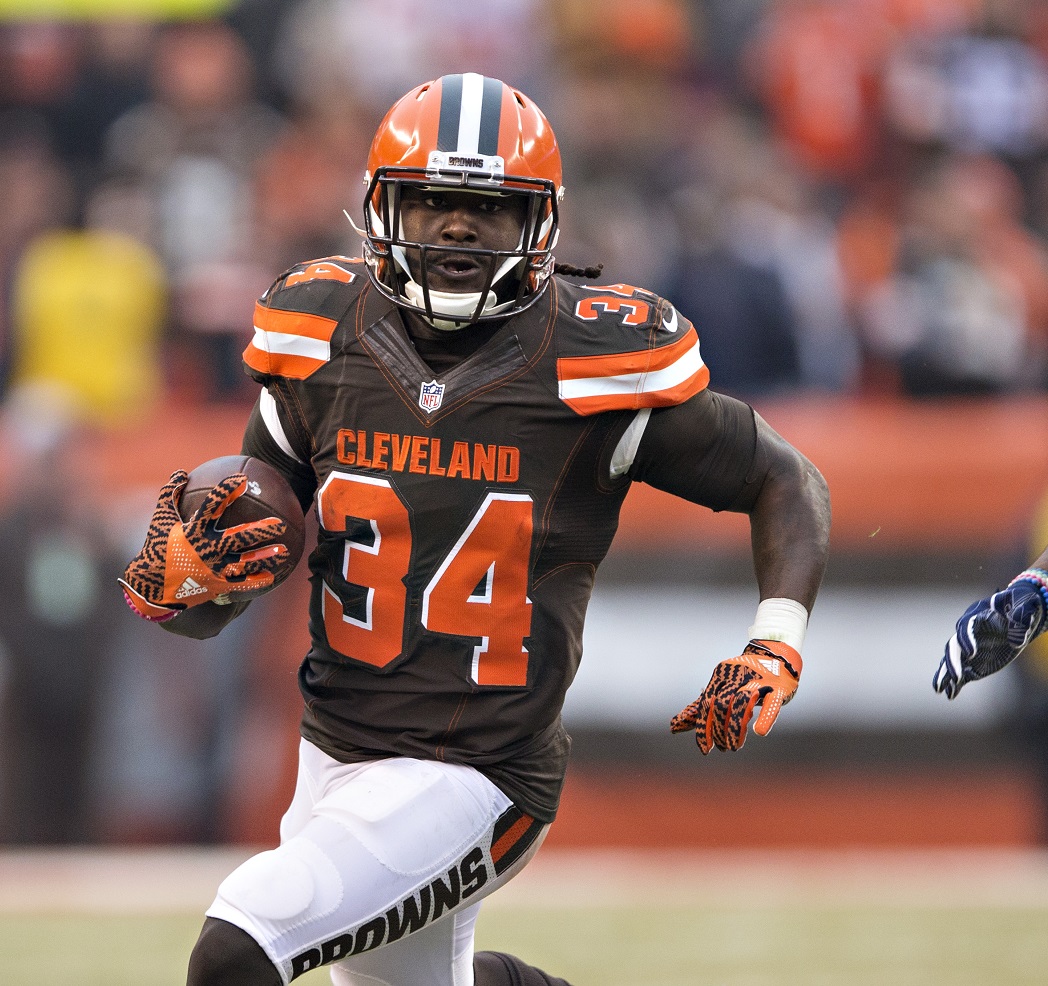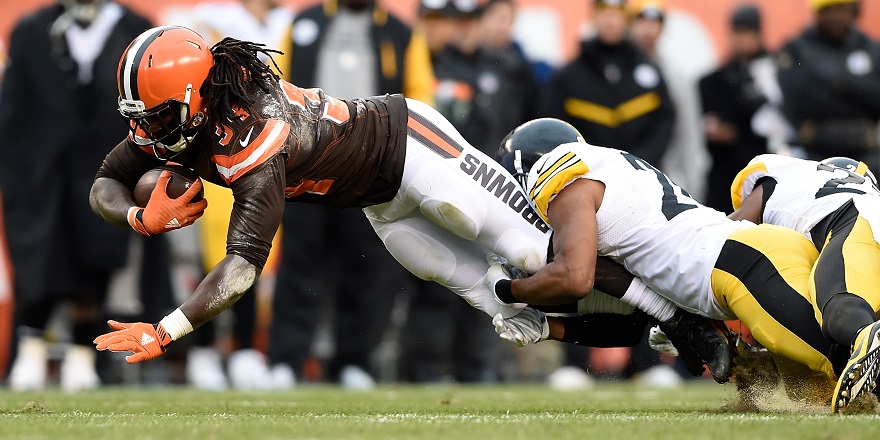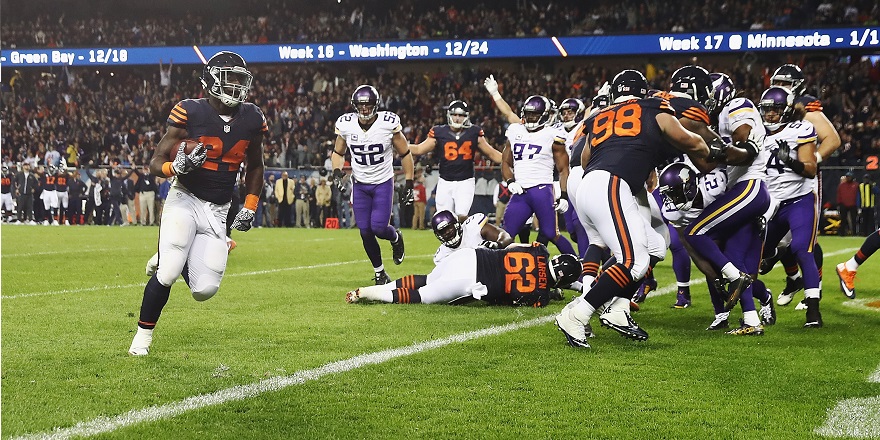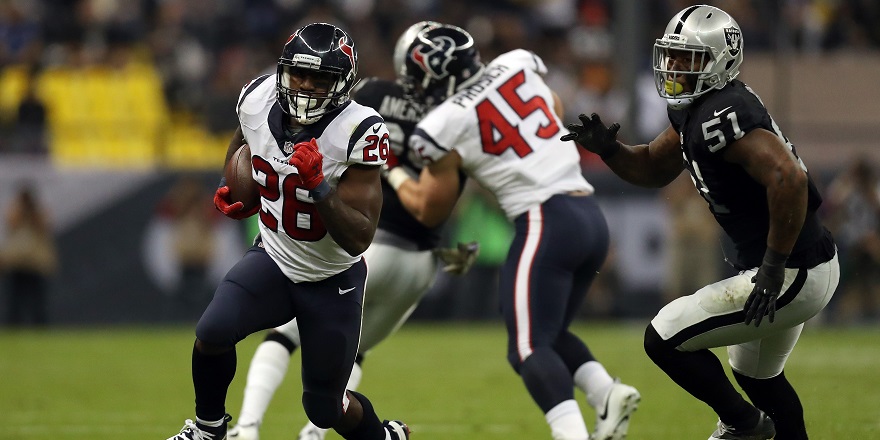It was hardly coincidental the Patriots and Cowboys had the most fourth-quarter snaps while leading in 2016, and Ezekiel Elliott and LeGarrette Blount each had at least 20 more fourth-quarter rushing attempts than any other runner. The best teams typically have late leads and hand the ball off often. The concept of late-game flow and its effect on running back production isn’t rocket science.
Examining late-game flow allows us to compare expectations set by last year’s results with forecasts of the coming season. When there is a disconnect between the two, we can take advantage. Last offseason, it helped to put us on Jordan Howard, DeMarco and Latavius Murray, and to push away from Matt Jones and Matt Forte. It was similarly helpful the prior offseason.
Flowing up
Isaiah Crowell, Cleveland Browns
The Browns were winning during the fourth quarter on a comically low seven percent of snaps – the only team in the single digits last season. They threw the ball on an NFL-high 77 percent of their fourth-quarter plays, and on 81 percent while trailing. Cleveland is projected to win three more games than last season, which ties for the largest forecast improvement. It would be more impressive if they hadn’t only scratched out one victory in 2016, but the main takeaway is it’d be hard for their late-game scripts to be any worse.
Crowell produced only 17.6 percent of his points during fourth quarters in 2016 and still finished as a borderline fantasy RB1. He scored zero fourth-quarter touchdowns, and his 32 fourth-quarter rushing attempts were the 33rd-most. Crowell had the 18th-most handoffs during the first three quarters. Touchdown scoring is fickle, but it’s no coincidence all seven of Crowell’s came during the first halves of games, while the Browns still theoretically had a chance. Less Robert Griffin III and more of the underrated Cody Kessler – or DeShone Kizer if he beats the Kessler baseline – will have the Browns in position to score more often than last year.
Even if the Browns don’t actually reach four wins, Crowell can build on a strong 2016 season while the team stays competitive deeper into games. Cleveland ranked 19th in run blocking and significantly upgraded 40 percent of its starting offensive line. Crowell was already afforded 1.6 yards before contact per attempt in 2016, while the average among 100-carry running backs was 1.4 yards. Crowell then ranked third in average yards after contact (3.2). He also was the ninth-most-targeted running back after Week 8, when he saw seven more looks than pass-catching teammate Duke Johnson. Crowell has clear fantasy RB1 upside (he is my overall RB10) and is available in the fourth round.
Carlos Hyde, San Francisco 49ers
The two-win 49ers (89 percent) were the only team to trail on a higher percentage of fourth-quarter snaps than the Browns (86), albeit by a narrow margin. No team was close to San Francisco’s second-half trail rate of 86 percent, with Cleveland the “runner up” at 77 percent. While it’s not surprising the 49ers were often in negative late-game scripts, it’s striking how consistently they were playing uphill for prolonged periods. They led on only 58 of their 481 second-half plays, held a second-half lead of any size in just four games, and had the league’s seventh-fewest second-half rushing attempts.
Only 36 of Carlos Hyde’s 217 handoffs came in the fourth quarter (16.6 percent). He ranked 12th in rushing attempts through three quarters (181) and 29th in fourth-quarter carries. Will 2017 bring him more opportunities to pad fantasy stats late in games? Reasonable minds disagree and will continue debating his place on the 49ers’ depth chart relative to fourth-round hype-machine Joe Williams, but less uncertain is if San Francisco will hang in games more often. They are projected to win an additional 2.5 games under new head coach Kyle Shanahan, tied for the league’s second highest increase.
Hyde is currently the 15th running back chosen in MFL10s, which is roughly where he finished 2016 (RB15 standard, RB17 PPR). His ADP has fallen more than a full round since April 1. Hyde is not fun to draft right now, but assuming he holds off a “hand-picked” rookie (do other teams pick out of a hat?) who had trouble catching and hanging onto footballs, his ADP is quickly approaching value territory.
Other notables
Melvin Gordon already derived 27 percent of his fantasy points in the fourth quarter last year (28 percent in PPR) despite scoring only one touchdown, and the Chargers are projected to win an additional 2.5 games. They led for only 34 percent of fourth-quarter plays (23rd-most). Gordon’s 69 fourth-quarter rushing attempts tied for the fourth-most despite his season ending eight snaps into Week 14. Not only does this bode well for Gordon’s 2017 prospects, but it heightens the need for us to identify his backup. He was sixth in snaps, 10th in handoffs, and 16th in receptions among running backs, despite missing a serious chunk of time. If Branden Oliver is indeed the next in line, he’s flying too far under the radar.
Running backs who score a disproportionate amount of their points in the fourth quarter are often of the pass-catching variety, and 2016 was no exception. Chris Thompson (39 percent), Jerick McKinnon (35), and Theo Riddick (34) placed top-five among all 100-point backs. Each has more touch competition now, so it’s natural to expect a decline in production. Thompson and Riddick, however, have a firm grasp on a defined backfield role, and both the Lions (-1.0) and Redskins (-0.5) project for fewer wins. They also ranked seventh (63 percent) and 12th (61), respectively, in fourth quarter trail rate. Allowing Samaje Perine and Ameer Abdullah to scare us off of Thompson and Riddick in PPR leagues is rash.
The Bears had the fourth-fewest fourth-quarter plays while leading, but in those situations, they ran the ball at a pretty nice clip (69 percent; fourth-highest). They went pass-happy when trailing late, throwing on 83 percent of fourth-quarter plays while losing (seventh-highest). Jordan Howard’s late-game production was throttled, considering Chicago had the most fourth-quarter plays while losing (245). Howard still produced the 12th-most fourth-quarter rushing attempts (57), accounting for 22.6 percent of his total carries – but imagine if they’d hung in more contests. Fortunately, they are forecast to win two more games in 2017. The Bears graded 13th in run-blocking despite dealing with offensive line injuries. Add in an improving defense and Howard is staring at increasingly frequent full-game workloads.
The Patriots led on 77 percent of second-half plays (395 total snaps) and 76 percent of fourth quarter plays (204). They ran the ball 127 times while leading in the fourth quarter. New England is projected for a league-high 11 wins, or three fewer than they won last season. While they appear stacked, it doesn’t hurt to factor some regression. They probably won’t go the entire season without throwing a second-half interception again. Probably. Even if they do regress, they’d have to fall far for Mike Gillislee to not see a truckload of late-game opportunities. LeGarrette Blount had 163 second-half touches, and 92 in the fourth quarter. Gillislee was one of only two backs to rank top-10 in average yards before contact, average yards after contact, and forced missed tackles per attempt. He could sleepwalk to 10 touchdowns.
Flowing down
Marshawn Lynch, Oakland Raiders
Throwing cold water on Lynch is tough. Who among us doesn’t love Marshawn? Who hates fun? Never mind Lynch could easily wind up with double-digit touchdowns and more than justify an increasingly pricey draft cost (MFL10 ADP: RB17; early-fourth round). Over his last three seasons, Lynch forced one missed tackle every 3.4, 3.1, and 3.9 touches. Last year, Jay Ajayi led the league with one every 4.6 touches. Lynch averaged 1.2 yards before initial contact his final season in Seattle, and Raiders running backs enjoyed over an extra half-yard more that in 2016 (1.8). Lynch will have the best run blocking of his career, by far.
Marshawn Lynch's team run block grade rank
'15: 29th
'14: 23
'13: 22
'12: 9 (5.0 YPC)
'11: 22
'10: 27
'09: 24
'08: 32
'07: 31OAK '16: 5th
— Pat Thorman (@Pat_Thorman) April 26, 2017
So why is he here? Aside from the unknown of how much is left in the tank of a high-mileage battering ram with a chronic back problem — who spent the past year making YouTube gold – the Raiders may not have late-game scripts in their favor as often as last season. They led on the 12th-highest percentage of second-half plays and at the seventh-highest rate during the fourth quarter. They had the fifth-highest fourth-quarter run rate and the sixth-most fourth-quarter rushing attempts while leading, which helped Latavius Murray sneak into the top-10 in fourth-quarter fantasy production.
Oakland is projected to win 2.5 fewer games than last season, which is tied for the league’s third-largest dropoff. They play in what should be the NFL’s best division, and if the Raiders indeed lose two or three more games and fall to the middle of the pack in late-game script, it likely means fewer opportunities for the early-down runner in a backfield chock-full of pass-catching talent. Throw in the fifth-toughest running back schedule according to our own Scott Barrett, on top of Lynch seemingly costing more each time we enter a draft room, and there are potential hiccups in the revival of one of the league’s favorite sons.
Lamar Miller, Houston Texans
The Texans scratched together nine wins and a division title despite the fourth-worst point differential in the AFC, and it’s no wonder they are projected to win 8.5 games despite paying a ransom to throw Brock Osweiler overboard. While Tom Savage and/or rookie Deshaun Watson can’t be any worse, there is no guarantee they maintain an already-middling 40.5-percent lead rate in the fourth quarter (15th). If they don’t at least stay in that neighborhood – a script in which they ran on 68 percent of snaps while winning (seventh-highest) – Houston’s rushing totals could suffer disproportionately.
Miller derived 31 percent of his fantasy points in the fourth quarter last season. His 71 fourth-quarter rushing attempts trailed only Ezekiel Elliott and LeGarrette Blount. Whether we believe Miller is talented but overworked, or he suffered due to the Texans’ run-blocking (22nd-best grade), or because defenses didn’t respect Osweiler, the fact remains the first-year Texan was extremely volume-dependent. He ranked 45th in fantasy points per opportunity and 52nd in rushing grade. Now Miller has rookie D’Onta Foreman to cede touches to, the ninth-hardest running back schedule, and likely fewer late-game opportunities.
Other notables
Devonta Freeman had only 50 fourth-quarter rushing attempts (18th-most), which were even fewer than Devontae Booker. Considering the Falcons ran the fifth-most fourth-quarter plays with a lead, Freeman’s low total stands out. Of course, Tevin Coleman’s 31 carries in the fourth quarter played a role. Freeman only garnered 17 percent of his fantasy stats in the final quarter of games, which ranked fourth-lowest out of 37 backs with 100 fantasy points. This could very well be an anomaly, but if it’s a trend, it doesn’t bode well for a running back who needs to be picked near the end of the first round in MFL10s. Atlanta is projected to win one fewer game than 2016, when seemingly everything broke right.
Spencer Ware’s ADP dropped more than a full round since mid-April, due mostly to the Chiefs’ drafting of Kareem Hunt. Backfield competition isn’t Ware’s only worry, however. Kansas City led on 59 percent of fourth-quarter plays last season (fourth-highest), and Ware derived over 28 percent of his PPR points in fourth quarters. The Chiefs are projected to win three fewer games in 2017. While this may portend more passing, and 45 percent of Ware’s points came through the air, will he see hefty pass-catching workloads again? Week 1 and Week 7 alone accounted for 37 percent of his passing game points, and Tyreek Hill and perhaps Hunt or Charcandrick West will absorb some targets Ware made hay on. We can’t expect the Chiefs — who have run the 27th-, 31st-, and 29th-most plays – to morph into a high-volume offense to backfill opportunities for Ware.
The Dolphins project to win 2.5 fewer games and finish just below .500 in 2017. They led on 39 percent of their fourth-quarter snaps last season (18th-most), but only had the 27th-most fourth-quarter handoffs (91). Jay Ajayi’s outlook is dampened if Miami controls fewer games. He already derived an outsized portion of his fantasy points in the fourth quarter (28 percent), mainly on the back of the second-most fourth-quarter rushing yards (385). This is not to say Ajayi should be avoided. He earned our third-highest rushing grade on a per-attempt basis, led the league in average yards after contact, and he’s slated to see more passing game work. Then again, Ajayi’s talent has never been what’s held him back in fantasy.
The Lions were the only team to run the ball less than half of the time while winning in the fourth quarter. It happened, in part, due to having few large leads, or many leads at all. Their 30.3-percent fourth-quarter lead rate ranked seventh-lowest — a remarkable stat, considering they made the playoffs. Detroit is projected for 1.5 fewer wins, which makes sense. They had a -12 point differential, barely upgraded the 31st-graded defense they tried to hide with a 60.5-plays-per-game offensive pace after Week 4 (second-fewest), and their big offseason move was signing two quality offensive lineman to replace a pair of marginally-lesser-quality lineman. Ameer Abdullah is building sleeper buzz, but negative late-game scripts benefit Theo Riddick more — and the Lions just dropped fantasy succubus Matt Asiata into an already-crowded backfield.






 © 2025 PFF - all rights reserved.
© 2025 PFF - all rights reserved.